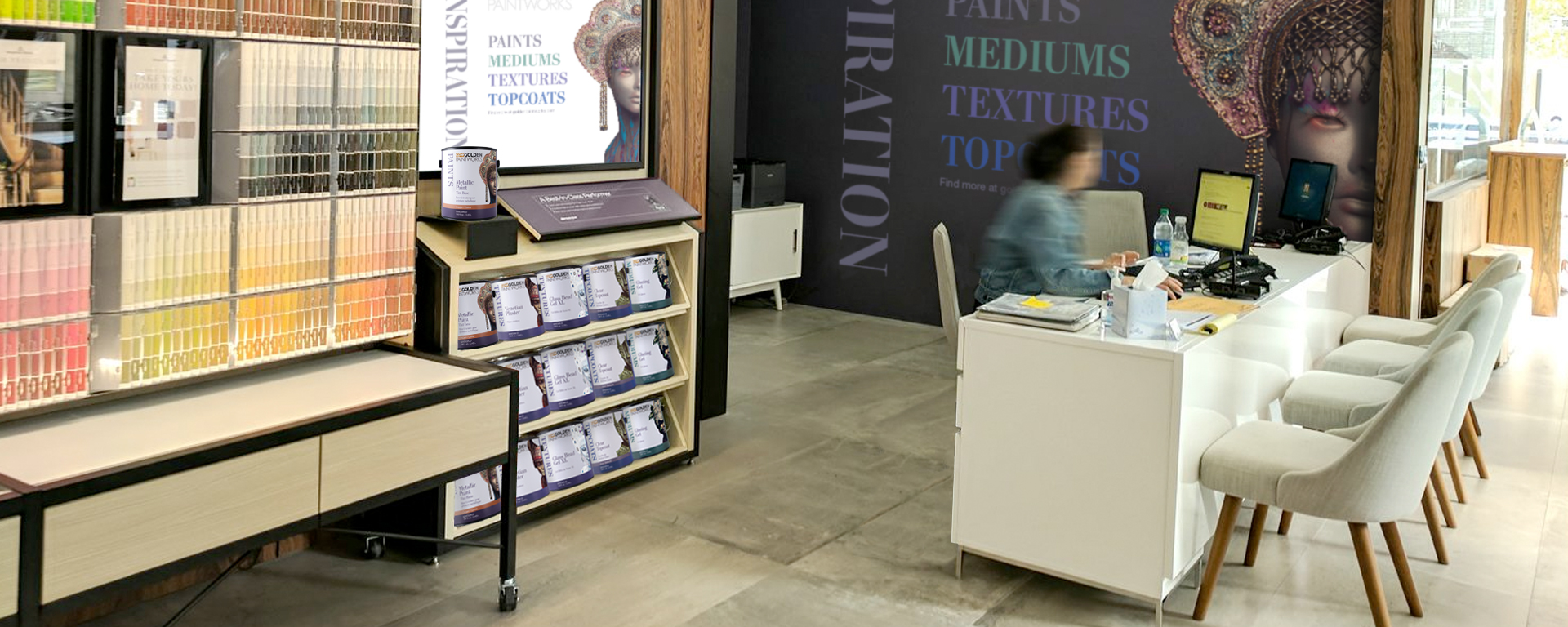
Resources & Technical Sheets
Find support materials to guide you through projects. If you don’t find what you need, please contact us.
Looking to elevate your space, but want some help? Find a decorative artist near you today! The International Decorative Artisans League (IDAL) is a community of around 300 professional decorative artisans that provides educational opportunities and support to those who have a passion for interior decorative art.
Decorative
Textures
Acrylic Limewash Technical Data Sheet
Fresco Technical Data Sheet
Glass Bead Gel Technical Data Sheet
Glass Bead Gel XL Technical Data Sheet
Glass Bead Undercoat Technical Data Sheet
Metallic Textures Technical Data Sheet
Sandstone Technical Data Sheet
Soapstone Technical Data Sheet
Textures SDS
Venetian Plaster Technical Data Sheet
Weathered Granite Technical Data Sheet
Mural & Theme Paint
Mural & Theme Paint
Mural & Theme Paint Technical Data Sheet
Mural & Theme Paint Application Data Sheet
Mural & Theme Paint SDS
Mural Paint Pigment ID Chart
Mural & Theme Paint Color Chart
Recommended Colors for Exterior Murals
Mural Non-Color Products
Acrylic Topcoats with UVLS Technical Data Sheet
Acrylic Topcoats with UVLS SDS
Mural Isolation Coat Technical Data Sheet
Mural Varnish Semi-Gloss Technical Data Sheet
Mural Varnish Satin Technical Data Sheet
Mural Solvent Technical Data Sheet
Mural Adhesive Gel Technical Data Sheet
Mural Isolation Coat SDS
Mural Varnish SDS
Mural Solvent SDS
Mural Adhesive Gel SDS
Theme Paint
Theme Paint Technical Data Sheet
Theme Paint SDS
Theme Paint Fluid Fluorescent SDS
Decorative Products FAQs
If your existing wall has been previously painted and is in good condition, a primer may not be necessary. If applying a Glass Bead Texture, a high quality primer is required to prevent potential discoloration from the wall material. New walls should be primed with two coats of a high-quality, acrylic primer and allowed to dry thoroughly before applying any product. Follow instructions on the label.
Not all GPW products require a tinted basecoat before product application. Typically, a basecoat is important when applying any translucent product or using a technique where the basecoat could show through to become part of the final finish. For example, the color of the basecoat is important when applying Glass Beads Gels, which are clear, or when executing a strié technique. Also, it is much easier to apply a Metallic Texture or Metallic Paint over a similarly colored basecoat, as it will require fewer coats.
We strongly recommend sealing any stained areas with a high-quality, stain-blocking primer (KILZ® Premium or Cover-Stain® by Zinsser) to prevent impurities in the wall or paint film from telegraphing through to the final finish. This is particularly critical if you are applying GPW Glass Bead Gels.
Most types of rigid or flexible material that paint will adhere to, may be used to apply the GPW products. If applying Glass Bead Gels or Glazing Gel Medium, DO NOT USE Luan Plywood Panels as a substrate. Luan has excessive tannins which the Gels will pull to the surface, even thru a Stain-Blocking Primer. Instead, use a Hardboard Panel, but it must be primed with a Stain-Blocking Primer prior to applying GPW Gels.
All GPW textures are acrylic based and are compatible with latex paints and primers. When someone uses one of the textures and then is ready for a change, the wall can be skim coated with drywall compound to get it back to smooth again before painting with a standard architectural paint, or another decorative finish.
It is best to have your knowledgeable Paint Retailer or Decorative Studio color the products. They have the expertise, tints and tools to do this. However, if you want to create your own colors, here are some guidelines:
- Metallic Paints and Metallic Textures develop colors very quickly, so a small amount of Universal Colorant or GPW Slow Dry Acrylics go a long way. Their viscosities are lower than the rest of the GPW line so they are easily mixed to a uniform color. The Metallic Texture can be color adjusted using our Metallic Paints, up to 16oz to a Gallon.
- The majority of GPW products are heavier Texture products. Tinting Textures is different than tinting paints. They are much denser than paint and therefore, will require extra mixing time and energy to create a uniform color. This is true for any product with a similar high viscosity.
To make light colors: Use Universal Tints, GPW Slow Dry Fluid Acrylics or any tinted acrylic paint to slightly change the color of the products.
To make Mid-Tones and Deep Tones: Use any brand of Universal Tint Colorant (Mixol, Tints-All, Cal-Tints, Proline Tints, etc.). These are similar to the colorants used by paint stores in their automatic tint machines but are available for purchase in small containers.
Check the instructions on the label first. However, as a general rule, add no more than 10% colorant by volume. Any greater amount may degrade the products overall fil integrity. If you are tinting the product yourself, practice mixing your desired color on a small scale and record your ratios, before attempting to mix a full container of product. Try to use only transparent pigments (organic) when tinting Metallic Paints or Metallic Textures.
The short answer is no. The varying types of pigments and aggregates in the GPW Textures are not present in a standard architectural paint base, which means the color intensity will be different. Some deeper, some lighter.
Most GPW products may be applied with a brush, trowel or roller, or even a rag. The application tool will impact the look of the finish. In most cases, when using a tool other than a trowel, the product should be thinned to make it easier to work with. Below is a brief guide to application options relative to different types of tools.
- GPW Sandstone & GPW Glass Bead Undercoat: These products do well being troweled on. If thinned, they can also be brush or roller applied. Suggested thinning ratio is 1:1 with water. Both products are slightly absorbent and hold topcoats and glazing quite well.
- Weathered Granite: These products do well troweled, brushed or rolled and have excellent opacity in one coat. Weathered Granite looks beautiful untinted as the aggregates will crush and move slightly while troweling. Thinning is recommended for smooth applications; up to 25% volume water to product. Translucent glazes may be applied on top of both products.
- Glass Bead Gel & Glass Bead Gel XL: These products do best when troweled or bladed on in one smooth coat. They are difficult to roll or brush unless thinned with water up to 25%. Tint with transparent colorants, if at all. To avoid washing beads down the drain, clean tools with a paper towel before washing.
- Venetian Plaster & Metallic Texture: These products have best coverage in three coats and do well applied with a trowel or blade. They can also be applied by rolling, stippling, sponging or brushing. This product can be burnished. Venetian Plaster, if used in a high traffic area or in high humidity, should be top-coated with a clear, protective wax.
- Metallic Paints: These products are smooth like paint, can be thinned to apply through a cup gun sprayer. Since these paints contain high concentrations of mica pigments, the product must be applied with care to avoid lap or brush marks. Follow instructions. Use a microfiber roller, sprayer or sponge roller for the best overall wall effects. Cut-in with a smaller version of your choice of applicator. Finish your stroke in the same direction. These products will tint easily.
Either use a 3” spatula to dip into the container, or dole out the product into a mud pan or onto a plaster hawk.
Typically, it is coming from the base paint or primer under a too thin coat of Venetian Plaster. Any kind of steel blade that contacts paint will leave black carbon marks. Apply the Venetian Plaster in coats thick enough to completely cover the base paint/primer so that the blade is only burnishing plaster, not paint. Sand off the marks with 400 grit sandpaper and re-apply.
When the texture starts to dry, the steel of the trowel rubs over the sharp aggregates in the textures and leaves carbon marks. Either stop troweling before the texture dries or spray a light mist of water on the surface to lubricate.
Spray a light mist of water on the surface and using the steel trowel flat to the surface, start to rub in a circular motion until the black marks disappear. Clean off with a clean, dry, cotton rag.
Use a box cutter knife and a metal straight edge like a wide spackling knife to score a line along the edge of the tape and the surface. The tape should then come off in a clean line.
It is imperative that the entire finish has cured before applying a Clear Top Coat. Thicker finishes will take longer to cure as does any glazed finish. When applying a Clear Top Coat, allow the first coat to dry for at least 4 hours in a dry, warm environment or overnight if it is cool and/or humid before applying subsequent coats. If you get on it too quickly it may “fog” the clear coat and create a lot of brush drag.

